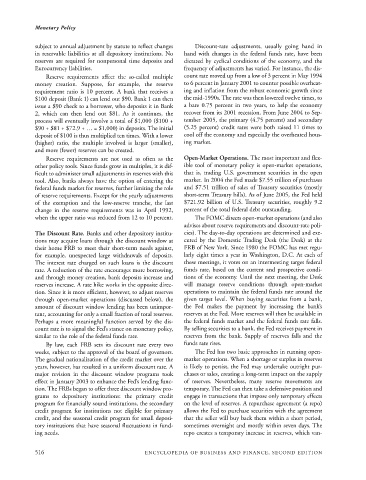Page 539 - Encyclopedia of Business and Finance
P. 539
eobf_M 7/5/06 3:15 PM Page 516
Monetary Policy
subject to annual adjustment by statute to reflect changes Discount-rate adjustments, usually going hand in
in reservable liabilities at all depository institutions. No hand with changes in the federal funds rate, have been
reserves are required for nonpersonal time deposits and dictated by cyclical conditions of the economy, and the
Eurocurrency liabilities. frequency of adjustments has varied. For instance, the dis-
Reserve requirements affect the so-called multiple count rate moved up from a low of 3 percent in May 1994
money creation. Suppose, for example, the reserve to 6 percent in January 2001 to counter possible overheat-
requirement ratio is 10 percent. A bank that receives a ing and inflation from the robust economic growth since
$100 deposit (Bank 1) can lend out $90. Bank 1 can then the mid-1990s. The rate was then lowered twelve times, to
issue a $90 check to a borrower, who deposits it in Bank a bare 0.75 percent in two years, to help the economy
2, which can then lend out $81. As it continues, the recover from its 2001 recession. From June 2004 to Sep-
process will eventually involve a total of $1,000 ($100 + tember 2005, the primary (4.75 percent) and secondary
$90 + $81 + $72.9 + … = $1,000) in deposits. The initial (5.25 percent) credit rates were both raised 11 times to
deposit of $100 is thus multiplied ten times. With a lower cool off the economy and especially the overheated hous-
(higher) ratio, the multiple involved is larger (smaller), ing market.
and more (fewer) reserves can be created.
Reserve requirements are not used as often as the Open-Market Operations. The most important and flex-
other policy tools. Since funds grow in multiples, it is dif- ible tool of monetary policy is open-market operations,
ficult to administer small adjustments in reserves with this that is, trading U.S. government securities in the open
tool. Also, banks always have the option of entering the market. In 2004 the Fed made $7.55 trillion of purchases
federal funds market for reserves, further limiting the role and $7.51 trillion of sales of Treasury securities (mostly
of reserve requirements. Except for the yearly adjustments short-term Treasury bills). As of June 2005, the Fed held
of the exemption and the low-reserve tranche, the last $721.92 billion of U.S. Treasury securities, roughly 9.2
change in the reserve requirements was in April 1992, percent of the total federal debt outstanding.
when the upper ratio was reduced from 12 to 10 percent. The FOMC directs open-market operations (and also
advises about reserve requirements and discount-rate poli-
The Discount Rate. Banks and other depository institu- cies). The day-to-day operations are determined and exe-
tions may acquire loans through the discount window at cuted by the Domestic Trading Desk (the Desk) at the
their home FRB to meet their short-term needs against, FRB of New York. Since 1980 the FOMC has met regu-
for example, unexpected large withdrawals of deposits. larly eight times a year in Washington, D.C. At each of
The interest rate charged on such loans is the discount these meetings, it votes on an intermeeting target federal
rate. A reduction of the rate encourages more borrowing, funds rate, based on the current and prospective condi-
and through money creation, bank deposits increase and tions of the economy. Until the next meeting, the Desk
reserves increase. A rate hike works in the opposite direc- will manage reserve conditions through open-market
tion. Since it is more efficient, however, to adjust reserves operations to maintain the federal funds rate around the
through open-market operations (discussed below), the given target level. When buying securities from a bank,
amount of discount window lending has been unimpor- the Fed makes the payment by increasing the bank’s
tant, accounting for only a small fraction of total reserves. reserves at the Fed. More reserves will then be available in
Perhaps a more meaningful function served by the dis- the federal funds market and the federal funds rate falls.
count rate is to signal the Fed’s stance on monetary policy, By selling securities to a bank, the Fed receives payment in
similar to the role of the federal funds rate. reserves from the bank. Supply of reserves falls and the
By law, each FRB sets its discount rate every two funds rate rises.
weeks, subject to the approval of the board of governors. The Fed has two basic approaches in running open-
The gradual nationalization of the credit market over the market operations. When a shortage or surplus in reserves
years, however, has resulted in a uniform discount rate. A is likely to persist, the Fed may undertake outright pur-
major revision in the discount window programs took chases or sales, creating a long-term impact on the supply
effect in January 2003 to enhance the Fed’s lending func- of reserves. Nevertheless, many reserve movements are
tion. The FRBs began to offer three discount window pro- temporary. The Fed can then take a defensive position and
grams to depository institutions: the primary credit engage in transactions that impose only temporary effects
program for financially sound institutions, the secondary on the level of reserves. A repurchase agreement (a repo)
credit program for institutions not eligible for primary allows the Fed to purchase securities with the agreement
credit, and the seasonal credit program for small deposi- that the seller will buy back them within a short period,
tory institutions that have seasonal fluctuations in fund- sometimes overnight and mostly within seven days. The
ing needs. repo creates a temporary increase in reserves, which van-
516 ENCYCLOPEDIA OF BUSINESS AND FINANCE, SECOND EDITION

